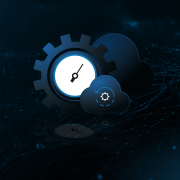
What you have to know about encryption
Basic task of backup is user data protection against failure, virus attack or accidental deleting of documents. It is performed by backup software, such as e.g. Xopero Backup & Restore. One question arises at this moment – how to protect the backup copy performed by us against unauthorized access?
The question of ensuring the security of data copies obtained as a result of backup is very often omitted in many articles and works concerning the protection of corporate information. Physical security of backup data itself doesn’t of course constitute a complicated issue and is in general realized in three basic ways.
Standard data replication mechanism constitutes the first example. All data stored on a storage device is automatically replicated to a different location to ensure its accessibility in case of physical damage of primary backup copy. Replication may be performed automatically or by backup software or (internal or external) storage system managing software. Such replication may be performed to a different network disc, DAT tapes, external server located outside the company’s seat or simply to cloud.
The second mechanism is… backup. In other words, we backup the data which was already backed up. Such duplicating data protection is used among others when our backup copy goes to the server located in external data center independent from us. In such case service provider is obliged to secure all customers’ data and backup is here the best way to do it. In this way, our backup copy is backed up automatically.
Third method consists in the creation of backup copy protecting data obtained through backup. Such copy may be recorded e.g. on a different NAS server located within the company or on a permanent carrier, such as Blu-ray or DVD, which should then be placed due to safety reasons in a fireproof safe cabinet, thus protecting it against fire and unauthorized access.
Data encryption
However, physical protection of backup copy which aims at preventing data loss resulting from the damage of its carrier is not enough for our files to be safe. All critical company data, together with all confidential information, should be protected against the access of unauthorized persons. But it’s difficult to protect company network in 100% against breaking in, data leak or physical stealing of a small NAS server. In such case all data, originating from all protected computers and servers and crucial for the functioning of the company, stored in the form of an unprotected backup copy, gets into wrong hands.
The best way to protect all critical and confidential data is to encrypt it. It is of course possible to encrypt full volumes to which backup copies go from all computers, but this method is particularly inconvenient when it comes to backup. Firstly, each reading and writing requires decryption and then new encryption. Such activities considerably slow down all reading and writing operations and are quite inconvenient when it comes to their implementation and use. What is more, data replication is hindered and the question what is replicated arises automatically – single files which will be automatically decrypted during their transfer to the other location, or else full encrypted volumes, which in turn forces us to send huge amounts of data through the network.
For this reason, encryption of single files created in subsequent sessions is used in backup systems. Two technical solutions are applied here – encryption on client’s side and encryption on the side of backup server. But we will discuss it in a moment.
AES algorithms
AES (Advanced Encryption Standard), also referred to as Rijndael from the surname of its creator, is currently the most frequently used encryption algorithm used by backup software. In 2001, AES was accepted as industry standard by American federal agency NIST (National Institute of Standards and Technology) serving a similar function as Central Office of Measures (GUM) in Poland. In the AES algorithm it is possible to use symmetric encryption keys, with the length of 128, 192 and 256 bits, and it operates on data blocks with the length of 128 bits. Original Rijndael specification also allows the use of 192- and 256-bit data blocks, but these sizes were not included in the standard. From time to time, 512- and 1024-bit encryption keys are applied, also beyond the official standard.
Using 256-bit encryption key means that there are 2^256 possible combinations of digits necessary to be checked during an attempt to break the code. This number is bigger than the number of atoms known in the universe and in spite of scientific magazines informing that there exists the possibility to break AES-256 algorithm in much shorter time than it would result from theoretical assumptions, until we have access to quantum computing, AES-256 encryption will be in practice considered a totally safe and effective way of protecting data.
Other encryption algorithms
In backup systems, apart from AES-256, other encryption methods are also applied. Fast and relatively safe RC4 or RC5 encryption is the most common, together with AES-128 encryption ensuring a lot of safety, where 128-bit encryption keys are applied. We can sometimes also encounter strong AES-512 encryption.
All of the abovementioned algorithms have their advantages and disadvantages. The method based on RC4/RC5 algorithms is fast and it doesn’t overload the resources, but it offers less safety than AES-128, which in turn constitutes good compromise between encryption speed and the safety of encrypted data. In corporate practice it is considered to be unbreakable, but according to scientific publications, the use of “only” 128-bit key makes it theoretically possible to break the AES code in a reasonable time with the use of a very powerful computer or a network of smaller distributed machines. This method is not useful nor recommended for the protection of critical and confidential data. It cannot be used in banking and financial sector or for government and military applications.
AES-256, apart from being a renowned and standardized method, makes it possible to secure all critical company data. This method was accepted to be used in the financial sector, in banking, in military applications as well as in public administration. However, it is necessary to remember that it is also much slower than AES-128. Using the AES-256 algorithm may reduce backup speed by up to 80% and thus proportionally extend its duration. Due to this important extension of the duration of backup copy creation process, backup software manufacturers are not willing to use AES-512, the most powerful among algorithms applied nowadays. In the majority of backup applications it is simply too slow.
Where to encrypt?
Finally, it is necessary to answer the question where the process of data encryption should take place. In the majority of backup applications available on the market, the encryption process takes places on the target side, i.e. on the server (it may also be the NAS server) or in data center to which our data goes. It creates the possibility for not encrypted confidential data to be captured on its way.
Xopero software mentioned at the beginning, both in the Xopero Cloud, Xopero QNAP Appliance as well as Xopero Backup & Restore version, uses the AES-256 encryption at the source side. In other words, backed up data is protected even before it is sent from user’s computer to the server, data center or cloud service provider. Without appropriate encryption key it is totally useless – even if on its way, somebody will manage to capture the entire data transmission.







